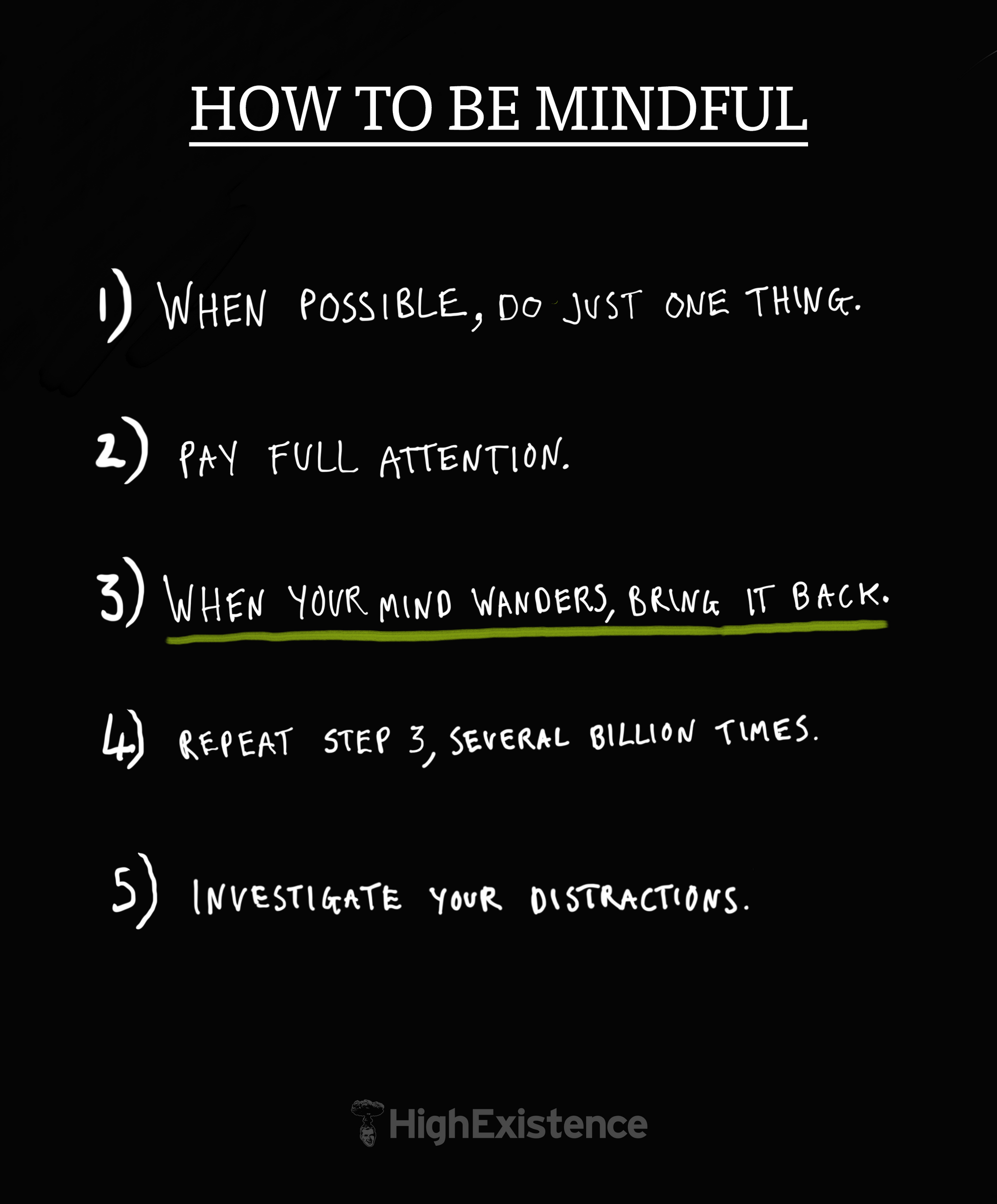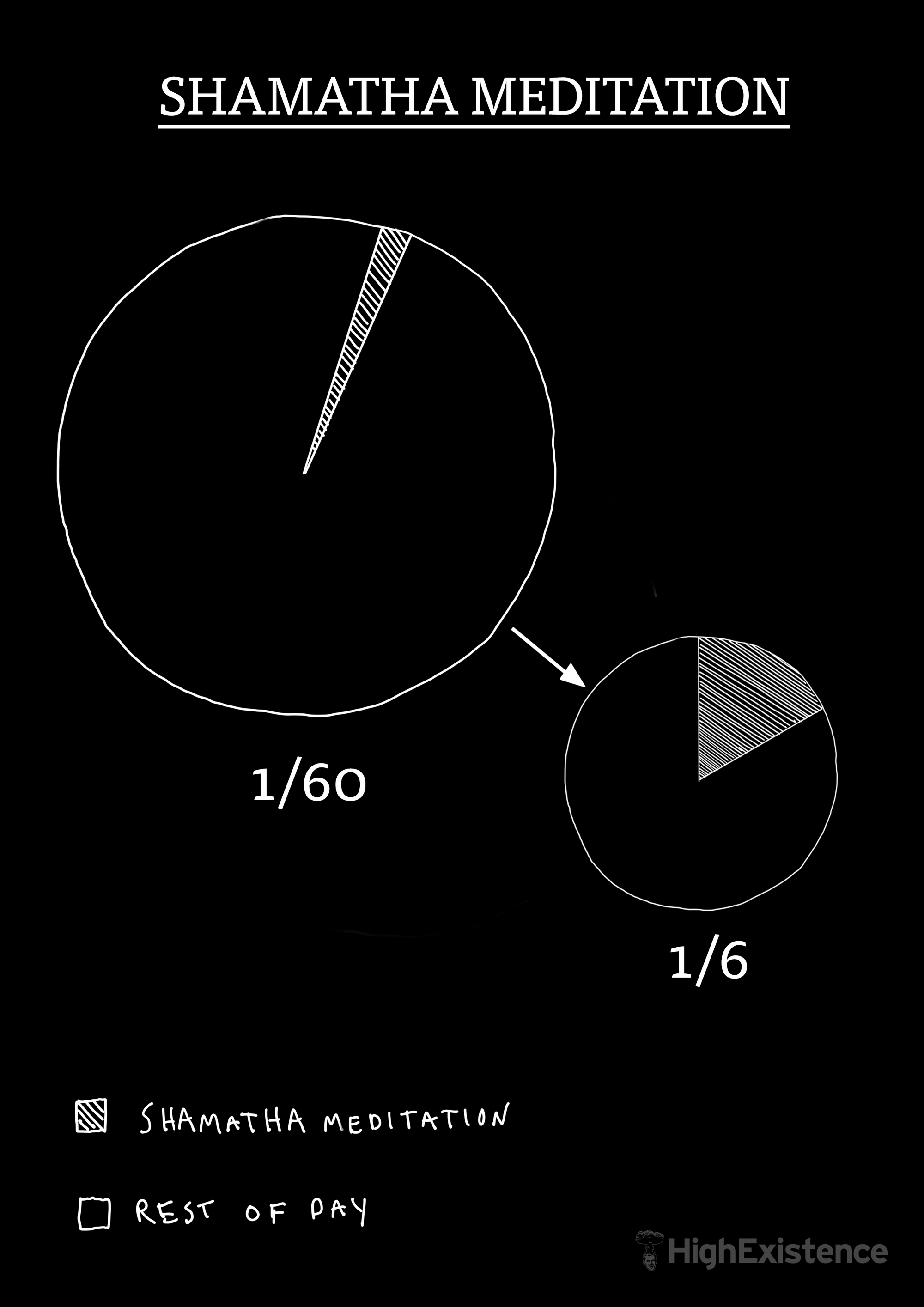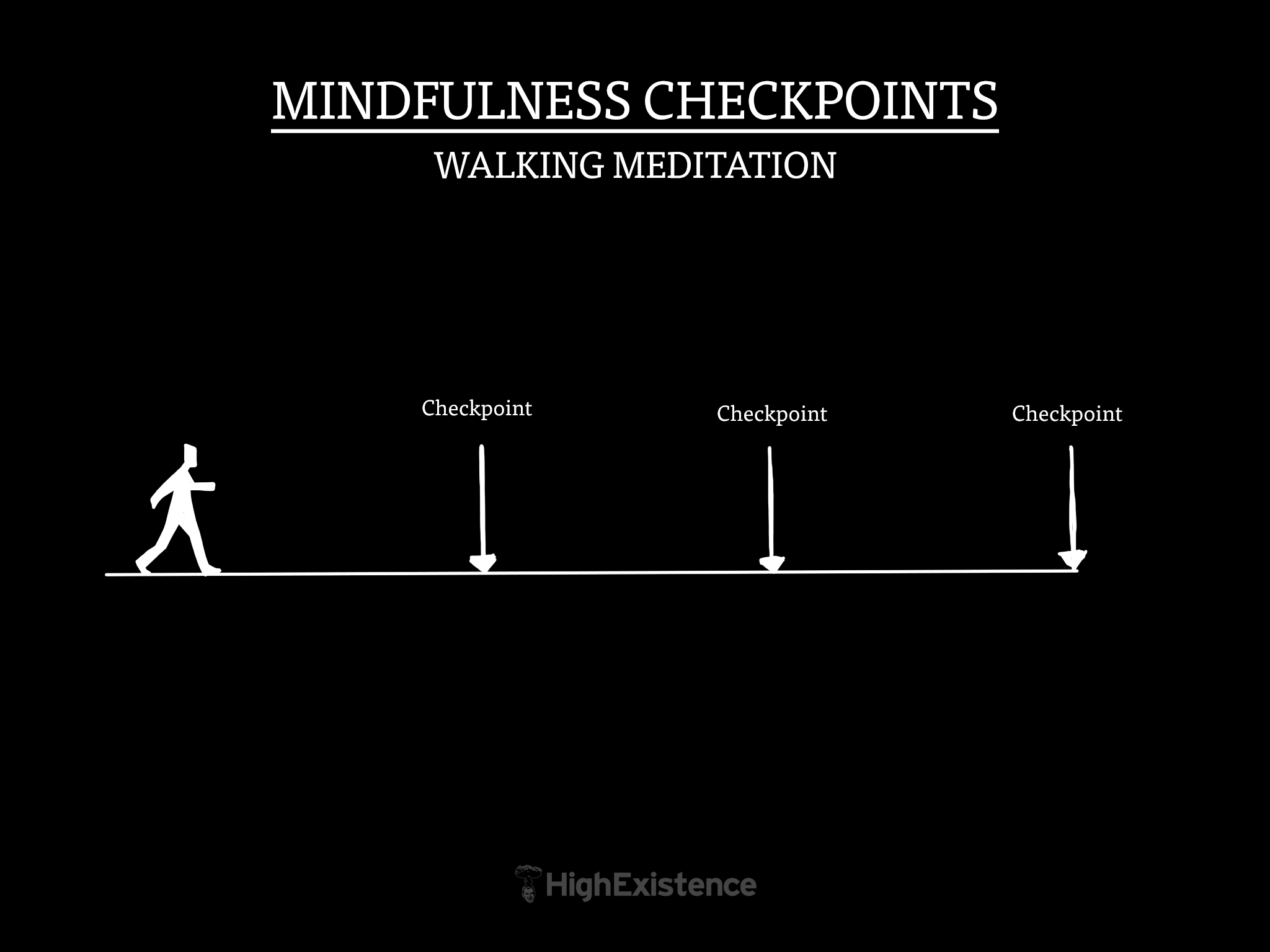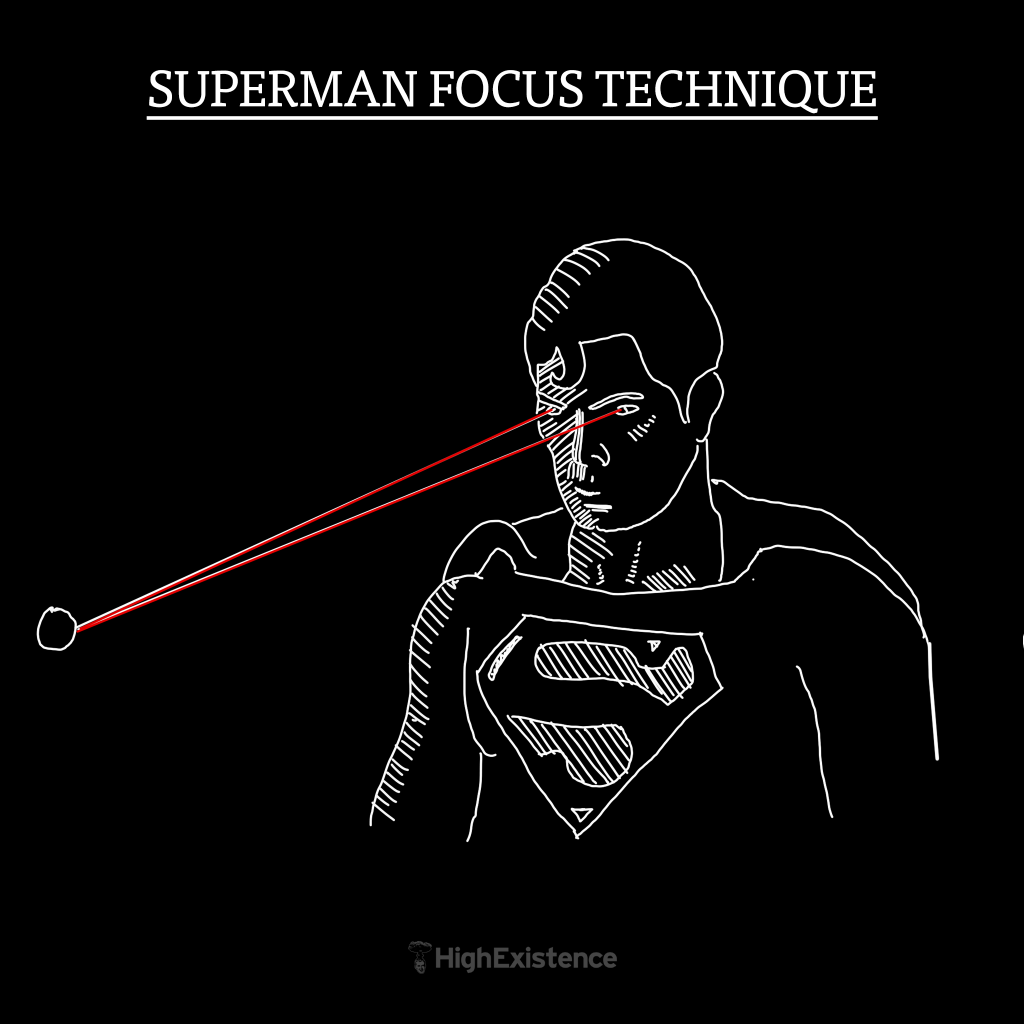Jon Brooks • • 13 min read
9 Mindfulness Exercises to Make You More Focused Than Eckhart Tolle on a Limitless Pill

“The truth is, just having a concentrated mind — that’s not getting lost in thought — is just intrinsically pleasurable. It’s intrinsically blissful. It’s the emotional bass note of all the good drug experiences.”
— Sam Harris, Neuroscientist
Having a highly-focused mind is like having a superpower.
Think of the geniuses throughout history. Among them all, you will find an ability to focus and sustain attention for long periods.
But this is not the norm.
We live in an age of chronic distraction.
Most of us can barely sustain our attention on a single object for a few minutes, let alone hours on end.
William James acknowledged the link between genius and attentional prowess, but concluded that the amount of attention one has “is probably a fixed characteristic of the individual.”[1]
It turns out James was wrong.
Thanks to the discovery of neuroplasticity, we now know that our brains are restructuring and learning based on the input we give them up until the day we die.
Attentional training is a pursuit no different from playing the piano or building a muscle. With enough repetition and drills, we can develop capacities that are far beyond our current reach.
By doing exercises that strengthen your attention, the levels of productivity you will experience are astounding. Imagine being able to sit down on your laptop for a few hours without getting distracted once—that means no quick Facebook checking, no web browsing, no day dreaming, just unconstrained laser focus on the task at hand.
The best productivity tool you can get is concentrated mind.
Beyond the productivity benefits that come with a laser-focused mind, Buddhist teacher B. Alan Wallace, Ph.D., says one can also expect:
- The effortless dissolution of bad habits and addictions
- Happy thoughts, devoid of hatred or delusion
- Unexplainable, drug-like bliss but with full clarity
- Increased compassion and confidence with others
- Profound, life-affirming insights into the nature of reality
Sound good?
So, how can we build our attention muscle?
ENTER MINDFULNESS.
Mindfulness, for our purposes, can be defined as attending continuously to a familiar object, without forgetfulness or distraction.
By actively engaging with mindfulness exercises, we can gradually cut down our susceptibility to distraction and cultivate a pure, focused mind.
I don’t want to complicate the process underlying mindfulness since everyone can already do it effortlessly. Larry Rosenberg, the author of the classic buddhist book Breath by Breath provides the following 5 steps for practicing mindfulness, which I like a lot:

The most important step is number 3. This is the practice of mindfulness. You will always get lost in thought, but as soon as you realize that you’ve become lost in thought, you no longer are.
Read This First—How to Use Mindfulness Exercises in Everyday Life:
Andy Puddicombe, ex-monk and co-founder of Headspace, writes in The Headspace Guide to Meditation and Mindfulness that the mindfulness momentum gained throughout the day can be compared to drawing a straight line.
He instructs us to:
Take a blank piece of paper and try drawing a straight line very slowly across the page. Even if you’ve got a very good eye, my guess is that there’ll be at least a few wobbles along the way. If you haven’t got a steady hand, the wobbles might be considerably greater. Let’s say that this line symbolizes your continuity of awareness throughout the day. When you’re aware, you tend to have a sense of calm, of focus, of direction… However, much like the line you drew across the page, for most people this idea of continuity of awareness tends to look very shaky.”
Andy explains a better approach:
“Now try imagining it a different way. This time imagine that the piece of paper has lots of very small dots on it, going from one side to the other. Each dot is very close to the next one on the page.

”Now try drawing the same straight line. My guess is it’s much easier now. All you have to do is focus on getting from one dot to the next. You don’t have to think as far ahead as the other side of the piece of paper, but just a few millimeters to reach the next dot. All of a sudden it’s not so difficult to draw a straight line. And if we continue the analogy of the line representing your sense of awareness (and therefore your emotional stability) throughout the day, then this is obviously very good news.”

This is how we should approach our mindfulness exercises.
Andy is not suggesting that we force ourselves to be mindful for every moment of every day; he is suggesting that by doing a few mindfulness exercises throughout the day, our concentration between those exercises will automatically improve.
Below I am going to list 9 amazing mindfulness exercises that you can pepper throughout your day. I encourage you to try them all and add whichever ones you find most useful into your daily routine.
Mindfulness Exercise #1: Shamatha Meditation
This is number #1 for a reason. While the rest of the mindfulness exercises will prove extremely useful in strengthening your attention, there is no single better way to develop your attention than a daily shamatha meditation practice.
Shamatha (pronounced sha-ma-ta) is a path of attentional development that culminates in an attention that can be sustained for hours on end. B. Alan Wallace outlines the 10 stages of shamatha practice in his outstanding book The Attention Revolution, but there is little use me outlining all 10 stages here, since the last stages require a vocational commitment to the practice.
You can still reap great benefits, however, by practicing the initial stages.
In shamatha practice, one is advised to start meditating in 24-minute periods, which is 1/60th of a full day. Only when one is able to sustain attention throughout most of the 24-minute session does one increase the length of the meditation.
With enough practice, one may be able to meditate unwaveringly on their chosen object for up to four hours (1/6th of a day) or more.

I’ve condensed Wallace’s shamatha instruction into the most basic, practical steps below.
How to do shamatha meditation:
The Mindset
- Your attention should be alert—not tense, but balanced in the sweet spot between effort and relaxation. Do not try too hard to concentrate.
- Throughout the meditation, keep as physically still as you can. Avoid all unnecessary movement, such as scratching and fidgeting. You will find that the stillness of the body helps to settle the mind.
The Position
- Assume a posture that embodies the three qualities of relaxation, stillness, and vigilance.
- Wear loose, comfortable clothing.
- You can be seated on a cushion, sitting in a chair, or lying flat on your back.
- If you sit on a chair, rest your hands on your knees or lap and slightly raise your sternum, so that when you inhale you feel the sensations of the respiration naturally go to your belly.
- Your tongue can lightly touch your palate.
The Practice
- To begin, ground your awareness in the body. Bring awareness to the tactile sensations of the body, from the soles of your feet up to the crown of your head. Note the sensations in your shoulders and neck, and if you detect tightness there, release it. Likewise, be aware of the muscles of your face—your jaws, temple, and forehead, as well as your eyes—and soften the area that feels constricted. Let your face relax like that of a sleeping baby, and set your body at ease.
- Take three slow gentle deep breaths, breathing in and out through the nostrils. Breathe as if you were pouring water into a pot, filling it from the bottom up. When you deeply inhale first the abdomen, then the diaphragm, and finally the chest will expand.
- Let your awareness permeate your entire body as you do so, noting any sensations that arise in relation to the respiration. Luxuriate in these breaths, as if you were receiving a gentle massage from within.
- Settle the respiration into its natural flow. Keep breathing through your nostrils, noting the sensations of the respiration wherever they arise within your body. Observe the entire course of each in- and out-breath, noting whether it is long or short, deep or shallow, slow or fast. Don’t impose any rhythm on your breathing. Breathe so effortlessly that you feel as if your body were being breathed by your environment.
- Attend closely to the respiration, but without willfully influencing it in any way. Don’t even prefer one kind of breath over another. Don’t assume that rhythmic breathing is better than irregular breathing. Let the body breathe as if it were asleep, but mindfully vigilant.
The Distractions
- Thoughts or distractions in your environment are bound to arise. When you note that you have become distracted, instead of tightening up and forcing your attention back to the breath, simply let go of these thoughts and distractions. Especially with the out-breath, relax your extraneous thoughts, and happily let your attention settle back into the body.
- When you see that your mind has wandered, don’t get upset. Be happy that you’ve noticed the distraction and gently return to the breath. Again and again, counteract the agitation and turbulence of the mind by relaxing more deeply, not by contracting your body or mind. If any tension builds up in your shoulders, face, or eyes, release it. With each exhalation, release involuntary thoughts as if they were dry leaves blown away by a soft breeze.
For best results, do this meditation every day, and don’t increase the duration until you feel as though your meditations are consistently free from distractions.
For more information on the benefits of meditation, learn more here.
Mindfulness Exercise #2: Eating Meditation
A great way to add mindfulness exercises into your daily life is to pair them with activities you were going to do anyway. We all eat multiple times a day, so eating is a perfect opportunity to practice mindfulness.
As you will see throughout this article, I don’t want to put too much emphasis on the “correct method” to practice mindfulness. The way to eat mindfully is to simply be with the food that you’re eating. Instead of watching TV or reading while you eat, you look at your food, smell your food, and savor each bite.
If you would like a basic guideline to eating mindfully, follow these steps:
- Take three deep breaths.
- Look at your food.
- Think about where the food came from.
- Smell the food.
- Put the food in your mouth and note the texture, temperature, and flavor.
- Chew the food and note the sensations.
- Swallow the food and note the sensations.
Mindfulness Exercise #3: Productive Meditation
Productivity author Cal Newport in his book Deep Work places a high premium on one’s ability to concentrate for sustained periods. He offers a very nice technique for cultivating your focus.
He calls it “Productive Meditation,” and here’s how you do it:
Set aside some time (perhaps go for a walk) and think of a problem that you want to solve. It could be an important problem you need to solve, or it could be a more general problem such as “ending poverty.” All you do is think about the problem and it’s solutions. When your mind wanders, you simply bring your attention back to the problem just like you bring your attention back to the breath during meditation.
Read this: 60 Hours of Meditation in 5 Days: How the Whole World Became My Black Mirror
Mindfulness Exercise #4: Walking Meditation
Walking meditation is just the same as sitting meditation, except instead of focusing on the rise and fall of your breath, you focus on the soles of your feet.
Many people see walking meditation as something inferior to seated meditation. The truth is, walking meditation is every bit as powerful. What matters most is the intention you bring to the practice.
Walking meditation is fantastic because it can be done any time you’re on the move, whether you’re taking a trip to bathroom or going on a long hike.
Here’s how to do walking meditation:
- Take three deep breaths to settle the body.
- Start walking at a regular pace.
- Note the general sensations of your entire body.
- Move your focus to your legs, notice how they move.
- Zone in to the sensations of the soles of your feet.
It’s that simple. You don’t want to try and focus too hard so you miss things that are going on around you. It should be a relaxed focus—50% of your attention on your feet, the rest on your surroundings. You are using the meditation to become more aware of what is going on around you, not less aware.
Pro tip: To stop yourself from getting distracted during your walk, it helps to break things down into segments. To do this, pick an object in the near distance (such as a lamp post) and aim to do a walking meditation to this object. When you reach it, you can consider that walking meditation complete, and refresh your focus. I like to think of this technique as walking meditation checkpoints, similar to those found in video games.

Mindfulness Exercise #5: Superman Focus Technique
This mindfulness exercise utilizes “negative practice.” By consciously engaging with a state of anti-focus, you will by implication better understand the feeling of being focused.
If you’re a superhero fan, you’ll know that Superman has the ability to shoot laser beams out of his eye balls. You will be imitating Superman in this mindfulness exercise.

How to do the Superman Focus Technique:
- Take a small, plain object—a pebble would be ideal—and place it in front of you.
- Place your full visual attention on object for 30 seconds.
- Relax your focus, give your mind total freedom, and look away from the pebble for 30 seconds.
- Repeat step 2 and 3 for as may rounds as you like.
I learned this exercise from the Focus pack on the Headspace app.
[url=”https://highexistence.com/how-to-practice-mindfulness/” title=”The Ultimate Illustrated Guide to Mindfulness” ]
Mindfulness Exercise #6: Sitting and Standing
One of the best ways to cultivate your attentional strength is to shine the light of your awareness onto activities that were previously unconscious or automatic.
Throughout the average day, you’re likely to stand up and sit down many times. But are you actually aware when you do this? If you’re anything like me, you’re not.
Starting today, simply start noticing the sensations in your body every time you stand up or sit down. Before you stand up or sit down, make the decision to do so mindfully. This mindfulness exercise is not as easy as it sounds. At first you will forget to do it. But over time you will start to become more aware.
This little exercise is fantastic for adding “mindfulness dots” to your day.
Mindfulness Exercise #7: Mindfulness Notifications
It’s common practice in monasteries to use bells during meditation to help remind people to bring their attention back to their chosen object.
If you stop and think about it, life itself has meditation bells built into it. You can be walking down a street, lost in thought, then a police siren jolts you awake. Generally, whenever something gives you energy, good or bad, you can use it as a bell to bring you back to the present moment.
Most people find social media a major distraction and obstacle in the way of living a mindful existence. Instead of fighting against social media, you can use it as a gift to make you more mindful.
Whenever you receive a notification from Facebook or WhatsApp or whatever app you use, take a few conscious breaths and feel the sensations in your body before opening the notification.
Mindfulness Exercise #8: “Wake Up” Reminders
One of my favorite mindfulness exercises is what I like to call “wake up reminders.” The idea is simple but highly effective: you place mindfulness prompts in your environment that trigger you to wake up and pay attention. Every time you you look at one, you simply take a breath and bring your attention back to whatever it is you’re doing.
We loved this concept so much at HighExistence we decided to create our own Remindful Art. We realized that there wasn’t any beautiful, zen art out there that promotes the idea of mindfulness, so we made it. It’s not released yet, but if you’re like to know when it is and view the full collection just click here.

Mindfulness Exercise #9: Life Drawing/Painting
The philosopher Alain de Botton in his video Why We Should Draw More (and Photograph Less) says the following about the art critic John Ruskin:
He was very impressed by cameras, at first, but gradually he grew very suspicious of them, believing they blinded us to our surroundings. To try to correct this blindness, Ruskin recommended that all of us take up drawing, not with the view to become great artists, but simply because through the act of trying to recreate on paper what we see in the world, we study it in a way we never do when we take a photograph.
By keeping a sketch book, and drawing things in your environment, you will naturally hone your attentional muscles. It’s no coincidence that Leonardo da Vinci and Johann Wolfgang von Goethe, who are voted by many as the smartest men to ever have lived, were avid drawers.
You don’t just have to draw things in your environment. You can also draw diagrams or take what architect Norman Crowe calls “visual notes” to simplify the complex world around you.
Pro tip: If you want to improve your drawing skills, you can learn Leonardo da Vinci’s best drawing exercises in this article.
This is an unfinished painting of my mother looking at her laptop. I did it with my iPad Pro 9.7”:

Mindfulness Exercises Final Thoughts
You have everything you need in this article to develop a superhuman attention span. You understand how to use the mindfulness exercises (straight line analogy), know exactly how to meditate for concentration, and have multiple exercises you can slot throughout your day.
Play around with the mindfulness exercises and have fun. Mindfulness is a natural state that is accessible to everyone. All you need to do is make a little bit of effort to exercise your mindfulness muscle.
[1] James, Talks to Teachers: On Psychology; and to Students on Some of Life’s Ideals. (New York: W. W. Norton, 1899/1958), p. 84.
This article was originally published on ComfortPit.com

Jon Brooks
Jon Brooks is a Stoicism teacher and, crucially, practitioner. His Stoic meditations have accumulated thousands of listens, and he has created his own Stoic training program for modern-day Stoics.










